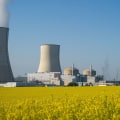In the event of a nuclear power plant being bombed, the consequences could be catastrophic. The International Atomic Energy Agency (IAEA) has developed a new Safety Guide to address the minimal volcanic hazards associated with nuclear plants. This guide makes use of probabilistic safety analysis to determine the maintenance and monitoring programs that should be implemented in order to ensure the health of all equipment in the plant. The European Nuclear Safety Regulators Group (ENSREG) was responsible for mobilizing considerable experience from different countries (500 man-years) to help with this process.
A nuclear explosion, caused by a nuclear bomb, involves the joining or splitting of atoms (fusion and fission) to produce an intense pulse or wave of heat, light, air pressure, and radiation. In the case of Ukraine's nuclear plant, no radiation leaks were reported and the plant did not suffer direct damage. The Nuclear Regulatory Commission (NRC) in the United States conducts Force Against Force (FOF) exercises at all nuclear power plant sites at least once every three years. Nuclear power plants, civil research reactors, naval fuel facilities, uranium enrichment plants, fuel manufacturing plants and uranium mines are all vulnerable to attacks that could lead to widespread radioactive contamination.
In the late 1970s, detailed analysis and large-scale testing began to make it clear that even the worst possible accident at a conventional Western nuclear power plant or its fuel would cause minimal public harm. This type of emergency does not involve splitting atoms to produce a nuclear explosion, but rather scatters smaller amounts of radioactive material into the surrounding area. The Centers for Disease Control and Prevention (CDC) has developed a fact sheet to describe what happens when a nuclear explosion occurs, the potential health effects, and what you can do to protect yourself in this type of emergency. Since the late 1980s, the OECD, IAEA and the Commission of the European Communities have carried out an international assistance program to bring Soviet-designed reactors up to safety standards close to Western ones or at least introduce significant improvements to plants and their operation.
However, it is important to consider that plans for nuclear energy should take into account the possibility of war. Terrorists could attack nuclear power plants in an attempt to release radioactive contamination in the community. Nuclear plant designs being developed for implementation in the coming decades contain numerous safety improvements based on operational experience. Government plans for remote location of nuclear plants in rural areas and transmission of electricity over high-voltage direct current lines to industrial regions would also improve safety and security.






